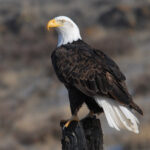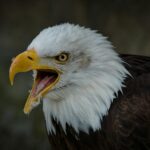Bald eagles are known for their impressive size, powerful talons, and keen eyesight, but do they eat plants? As carnivorous birds, bald eagles primarily feed on fish, but they are also opportunistic feeders, consuming a variety of other prey. In this blog post, we’ll explore the dietary habits of bald eagles and answer the question, “Do bald eagles eat plants?”
The Diet of Bald Eagles
Bald eagles are apex predators and play a crucial role in their ecosystems. Their diet consists primarily of fish, which they catch by swooping down from the air and snatching them from the water with their sharp talons. Some of the common fish species that bald eagles feed on include:
- Salmon
- Herring
- Shad
- Catfish
In addition to fish, bald eagles are also known to prey on:
- Small mammals, such as rabbits and muskrats
- Birds, including waterfowl and other smaller birds
- Reptiles and amphibians
- Carrion (dead animals)
- Invertebrates, such as crabs
Do Bald Eagles Eat Plants?
 Image source: Bald Eagle (Haliaeetus leucocephalus) in Kachemak Bay, Alaska
Image source: Bald Eagle (Haliaeetus leucocephalus) in Kachemak Bay, Alaska
No, bald eagles do not eat plants. As carnivorous birds, their diet is entirely focused on animal-based foods. Bald eagles are not equipped with the necessary digestive system or adaptations to consume and derive nutrients from plant matter.
Their sharp, hooked beak and powerful talons are designed for tearing and ripping apart their prey, not for grinding or chewing plant material. Bald eagles lack the specialized enzymes and gut bacteria required to break down the cellulose and other complex carbohydrates found in plants.
While bald eagles may occasionally come across or interact with plants in their environment, such as nesting in trees or perching on branches, they do not consume any part of the plants, including leaves, stems, fruits, or seeds.
Hunting Techniques of Bald Eagles
Bald eagles are skilled hunters, employing a variety of techniques to catch their prey. Their excellent eyesight, which is several times better than that of humans, allows them to spot their prey from great distances. They often soar high above the water, scanning the surface for any movement or signs of fish.
When a bald eagle spots its prey, it will dive down, sometimes at speeds of up to 100 miles per hour, and use its sharp talons to snatch the fish from the water. Bald eagles are also known to steal prey from other birds, such as ospreys, by chasing them and forcing them to drop their catch.
Habitat and Nesting of Bald Eagles
Bald eagles thrive in areas with abundant food sources, such as near large bodies of water like rivers, lakes, and coastal regions. They prefer to nest in tall trees or on cliffs, where they can have a clear view of their surroundings and easy access to their prey.
Bald eagles are known to be highly territorial and will aggressively defend their nesting sites and hunting grounds from other bald eagles and other predators. They typically mate for life and can live for 20 to 30 years in the wild.
Conservation Efforts for Bald Eagles
Bald eagles were once in danger of extinction due to factors such as habitat destruction, illegal hunting, and the use of pesticides like DDT, which caused the thinning of their eggshells. However, thanks to conservation efforts and the banning of DDT, the bald eagle population has made a remarkable recovery.
In 1963, the bald eagle was listed as an endangered species under the Endangered Species Act. Through various conservation initiatives, including habitat protection, law enforcement, and public education, the bald eagle population has steadily increased, and the species was removed from the endangered species list in 2007.
Today, bald eagles are protected under the Bald and Golden Eagle Protection Act, which prohibits the killing, selling, or possessing of these birds. Conservation efforts continue to ensure the long-term survival of this iconic American symbol.
Conclusion
In conclusion, bald eagles are strictly carnivorous birds and do not eat plants. Their diet consists primarily of fish, with a variety of other animal-based foods, such as small mammals, birds, reptiles, and carrion. Bald eagles are skilled hunters, using their excellent eyesight and powerful talons to catch their prey. While they may interact with plants in their environment, they do not consume any part of the plants. Conservation efforts have been crucial in the recovery of the bald eagle population, and these majestic birds continue to be a symbol of strength and resilience in the United States.
References:
- All About Birds, Bald Eagle Life History, Cornell Lab of Ornithology, https://www.allaboutbirds.org/guide/Bald_Eagle/lifehistory
- U.S. Fish and Wildlife Service, Bald Eagle – U.S. Fish and Wildlife Service, https://www.fws.gov/sites/default/files/documents/bald-eagle-fact-sheet.pdf
- The Peregrine Fund, Bald Eagle | The Peregrine Fund, https://peregrinefund.org/explore-raptors-species/eagles/bald-eagle
- Wikipedia, Bald eagle, https://en.wikipedia.org/wiki/Bald_eagle



